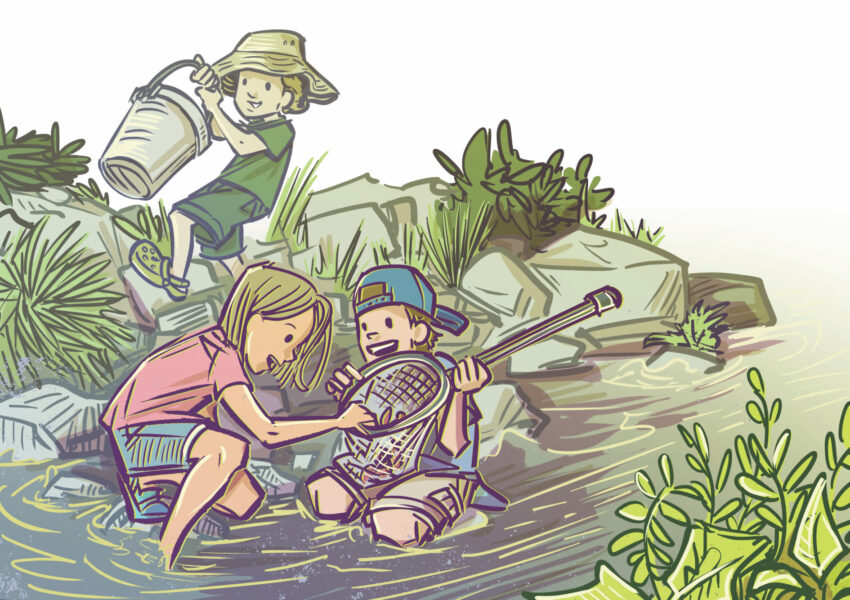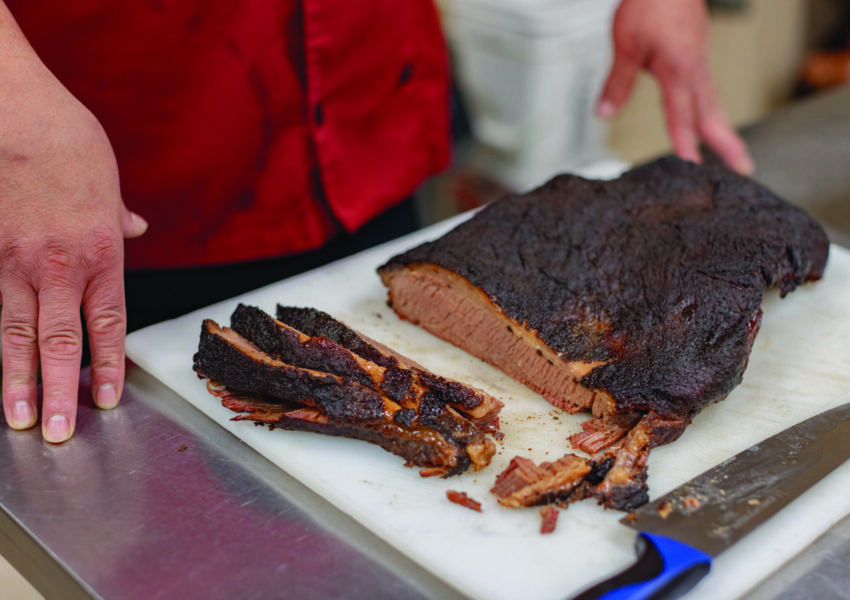In the Kitchen with Ashraf Aunty A new Southerner finds a familiar East African–Indian community in upstate South Carolina.
by Omme-Salma Rahemtullah
illustrations by Lindsey Bailey
![]()
Ashraf Ellison, who of course I call “Ashraf Aunty” out of respect, lives in a double-wide in Duncan, South Carolina, just west of the city of Spartanburg.
When I got to her house, her American husband, Lonnie Ellison, was making a cup of chai in the microwave. She told me that he loves the Indian-style milky tea more than she does. I was there to learn how to make fried mohogo, an East African–style cassava dish from her childhood in Jinja, Uganda. She told me that when she was a schoolgirl in the mid-1960s at the Madwani Girls High School, she and her friend Santhok were responsible for selling the snack at the school’s canteen. Cassava is a starchy root tuber native to South America that’s also a staple of many African cuisines. It’s known as yuca in Latin America, garri or manioc in West Africa, and mohogo in East African Swahili. The Ugandan school cooks boiled a huge vat of sliced mohogo then fried the slices in hot oil, resulting in a crispy snack a bit like a thick-cut french fry. Ashraf and Santhok would bring their Indian touch to the treat: a sprinkle of red chili powder and salt. “You know,” she says, “the local Africans would just boil it with tumeric, but we liked adding the chili.” If it was the right time of year, the mohogo would be accompanied by a fresh mango plucked from a tree nearby.
Ashraf Aunty was born in Uganda, a landlocked country in East Africa, and is of Indian descent. Her dad moved to Uganda from Kutch Mundra, in the western Indian province of Gujarat, likely in the late 1920s or early 1930s. Trade between the northwest coast of India and the east coast of Africa goes back centuries, following the tides of the monsoons that carried dhows across the Indian Ocean. In a world marred by imperial trade and empire building, it wasn’t long before the British began to exploit resources in the interior of East Africa, such as ivory and rubber, and created a cash cropping economy of tea and coffee in the favorable climate. In order to facilitate the transportation of these resources, and stake political control of the source of the Nile, the British colonial government indentured Indian labor to build a regional railway from the port of Mombasa on the shores of Kenya to an inland port on Lake Victoria in Uganda. Thirty-two thousand laborers from India, most of them Punjabi, built the railway between 1896 and 1901. After its completion, most of those workers returned home. Some 7,000 stayed, creating a settled community of Indians in East Africa. Though indentured contracts always promised a return home, Indian indentured laborers in other parts of the world, such as in the Caribbean or South Africa, usually stayed in their new homes and became part of the local populations.
Ashraf Aunty’s father was part of a second wave of Indian migration to East Africa. British colonial interests encouraged Indian immigrants to settle in communities along the rail line. While the ostensible promise to the new settlers was economic prosperity, most of the available jobs were in retail or clerical work and served to further British trade. This class of mostly dukawallas (general-store owners) “serve[d] as a buffer between Europeans and Africans in the middle rungs of commerce and administration,” wrote historian Jan Jelmert Jørgensen. When Ashraf Aunty’s father moved to Uganda at the age of fifteen to join his brothers, he initially worked in the shop of another Indian immigrant. Eventually, he saved enough money to buy his own shop deep in the countryside.
At the time of Ugandan independence in 1962, there were roughly 80,000 “Asians,” as they became known, in the country. Though they made up only 1 percent of the total population, they possessed outsized economic power. As Yasmin Alibhai-Brown, a Ugandan-British journalist, writes in her memoir The Settler’s Cookbook,“somewhere along the line, we were relabelled, no longer called ‘Indians’ but ‘Asians’ (an illogical label), thus confirming a shifting identity and the seep of modernism.” Though Alibhai-Brown considers the term “Asian” to be illogical, I actually prefer it, as it signifies a racial rather than national category. These Asians were two or more generations removed from the initial settlement of their ancestors. Having lost most connections and family ties to India, they called Uganda home.
That changed in August 1972, when Ugandan dictator Idi Amin declared that Ugandan Asians had ninety days to leave the country, regardless of their citizenship or documentation. Ashraf Aunty found out about the expulsion order on the front page of the local newspaper. She was twenty-four years old, recently married to her first husband, and a new mother.

A decade earlier, when Uganda became independent, Ashraf Aunty had chosen to retain her British subjecthood. She, and others in her situation, were forced to leave Uganda for England. She spent the next six months in a British refugee camp with her in-laws and two-year-old daughter. Meanwhile, her husband, who had been a Ugandan citizen, sought refuge first in Rwanda, then in a refugee camp in Naples, Italy, and was finally resettled in South Carolina. He was one of about 1,500 Ugadan Asians admitted to the United States under “parole” status. The responsibility of their settlement in the United States fell to sympathetic nonprofits and networks of volunteers. In South Carolina, the Tolstoy Foundation agreed to settle 500 Ugandan Asians in the state. Most of them were placed upstate, where jobs were available in the then-busy textile industry. It was the first such resettlement program in South Carolina. With the help of the Tolstoy Foundation, Ashraf Aunty and her daughter were eventually reunited with her husband.
Today, the number of Asians in East Africa is significantly less than it was a half-century ago. Thousands of Asians fled Kenya and Tanzania out of fear in the years that followed the 1972 expulsion from Uganda. Most of them settled in Europe or North America. Wherever they went, they took their recipes with them.
In a story as old as movement itself, migration brings with it adaptations of language and food, culture and family. Ashraf Aunty brought with her to South Carolina, as immigrants do, the foodways of her home. “You know, we call it mogo,” she says of the cassava we’re frying, “but it’s actually mohogo in Swahili. I guess Asians just didn’t know how to pronounce it.” When she first arrived in Spartanburg in 1972, she could not find the root vegetable in grocery stores; Americans just didn’t know what it was. She made do by substituting potatoes, but it wasn’t the same. But as the Mexican population increased, they knew what it was, she said. Now, yuca, as it’s usually called in Spanish, is available in the freezer case at her local Publix.
We chat and reminisce as we cook. We speak mostly in Kutchi, a language we share, and talk about the history of our jamatkhana in Spartanburg, the Ismaili Muslim mosque where we first met. Ashraf Aunty thaws the frozen mohogo and then cuts it into big chunks. After they are boiled in salted water, she drains them, telling me this also removes the excess starch. As she cuts them into smaller pieces, she is very particular about removing the fibrous chunks in the middle. Working in batches, she fries the pieces in hot oil and finishes them with a sprinkle of red chili powder mixed with salt, just as she did back at school in Jinja.
Ashraf Aunty and I share the same love for chili-spiced mohogo, as it reminds us both of home. Though I am not from Uganda, I was born in neighboring Tanzania to parents who were also born there. My maternal grandparents migrated to Tanzania in the 1920s from Rajkot, in the Indian state of Gujarat. The migration story on my father’s side is less certain, though we believe our first ancestor to leave India and sail to Zanzibar in East Africa was likely my paternal great-great grandmother. Through these generations, we maintained our Indian language, Kutchi, which comes from the Kutch (or Kathiawar) region of Gujarat. My family migrated from Tanzania to Canada in 1979, so I grew up mostly in Toronto. In 2017 I moved to Columbia, South Carolina, to be with my partner. I found a community of East African Asians whose recipes and food traditions were similar to my own, and I began to document their stories.
Over the past decade or so, South Asian foodways have gained attention and recognition in the South. Chefs like Vishwesh Bhatt, Cheetie Kumar, Meherwan Irani, and others tell their individual and collective stories through dishes like chaat and pakoras, cataloging the blending of two cultures and strong food traditions. But East African Asians have a fifty-year presence in the South, with little recognition of our food cultures. There are no restaurants serving our style of food here, so it remains within the walls of our home kitchens. I am often asked what my favorite Indian restaurant is in Columbia, because acquaintances assume I’m a native informant of all things Indian. I find it hard to offer an answer without delving into colonial histories of migration. If anything, when I moved to the South, I found a familiarity in Southern food: grits are similar to the East African staple ugali, and roadside boiled peanuts, a childhood treat I never really understood as quintessentially African, are my mother’s favorite whenever she comes to visit. After all, the foods of the South are African, and so am I.

When I moved to South Carolina, I wanted to cook the foods I’d grown up eating, and I also wanted to better understand the legacies of Black African cooking in the South. As a way to negotiate these desires and histories, I went on a quest to learn about and perfect a few dishes. From Ashraf Aunty, of course, I learned how to make fried mohogo. I had my mom teach me how to make the most perfect fluffy chora ja bhajia, black-eyed pea fritters—the field pea being another African ingredient that found its way onto Southern plates via the Transatlantic slave trade. I also searched for a home caterer who specialized in East African Asian food. In Toronto, we called these cooks “visi aunty.” They ran their businesses from high-rise apartments in the east end of the city.
A cousin in Atlanta told me about Naseem Vira, a home caterer from Tanzania who cooks the East African Asian delicacies of my childhood. I have yet to try her food, but when I reached her on the phone, she excitedly told me about her cooking style in her sweet, fast Kutchi. The menu she sells from her Atlanta home includes all of my favorites from my mom’s kitchen and my few visits to Tanzania. I long to try her kuku paka, slow cooked chicken in a thick rich yellow coconut curry; and sambusas, the East African variation on samosas that have a thinner crust and are filled with lightly spiced beef and onions. She also makes kokotende, a popular fried treat originating in Zanzibar, made from flour, coconut, and coconut milk, with a hint of cardamom. And no East African Asian menu could be complete without mandazi, a triangular fried sweet dough. It’s used to scoop up barazi, a dish of pigeon peas simmered in coconut milk. The pairing is reminiscent of the traditional Indian chapatis and daals.
Naseem Aunty moved from Tanzania to Atlanta to live close to her grown children, who had made Georgia home after attending college there. Naseem Aunty has quickly become a local star of East African Asian cooking among her community of Ismaili Muslims in suburban Atlanta. And she has managed to build a broader following: She told me that through word of mouth, and through sharing her food at mosque events, her customers now include Indians and Pakistanis throughout the Atlanta metro area.
“They were not used to our cooking before,” she said. “It’s very different, like a pilau. They just used garam masala only, and just the packaged spices. It’s very heavy with spices. We don’t do that. We start with a base of lots of onions and tomatoes and add only a few spices.” Potatoes, she explained, were also an addition to East African Asian cooking that she doesn’t often find in Indian cooking: “We use lots of potatoes in our biryani too. I’ve never seen them use potatoes in biryani.”
These subtle tweaks are what we’ve brought to Indian food via our generations-long lives and homes built in East Africa. Though such variations in ingredients and techniques might get lost in the ever-changing landscape of Southern immigrant cooking, they are immensely significant to our identities as East African Asians. That is why I find these practicess worthy of documenting and laying claim to: both to maintain the flavors of our African homes and to pass them on to our children. In doing so, we can affirm our identities as East African Asians in the United States. Ashraf Aunty, Nassem Aunty, and I take pride in the ways our ancestral Indian dishes have taken on new ingredients and cooking techniques to create a cuisine that marks our presence and identities as Africans.
On my first new year in my new home in South Carolina in 2018, my Southern husband informed me that we must have black-eyed peas and greens on New Year’s Day to bring us luck and prosperity. I think that was the moment I fell in love with the South. It felt like home. That New Year’s Day, and every one since, I’ve brought a twist on this Southern tradition into our home, one that is already a twist of African and Indian food traditions. I stock my kitchen with three bunches of collard greens, a bag of dried black-eyed peas, and plenty of onions and cilantro. On New Year’s Day, I fry chora ja bhajia as my mom taught me. I serve them with a side of coriander and coconut chutney—and a love for my homes here and across the world.
Omme-Salma Rahemtullah is an oral historian and the executive director of FoodShare South Carolina.
SIGN UP FOR THE DIGEST TO RECEIVE GRAVY IN YOUR INBOX.




